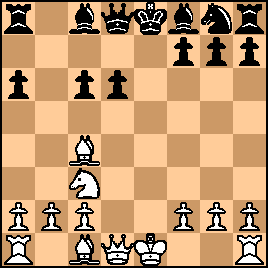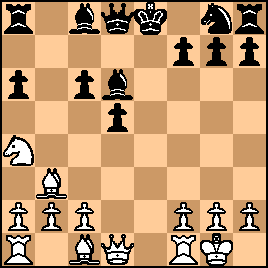| KEG: Tarrasch owned Marco for much of their respective careers. This was their eighth meeting, and their first draw. Tarrasch had won six of the earlier seven games, and that seems to have affected Marco here. Tarrasch tried something in the opening that looked loony,but most likely he was hoping Marco would overextend himself, being confident that he could outplay Marco if things got tough. Since Marco repeatedly back off, a short draw was the result. When the game was replayed five days later with colors reversed, Marco got crushed. But under the rules in effect at this tournament, Marco received 1/4 of a point for his efforts, and Tarrasch got 3/4ths of a point. 1. e4 c5
Announcing from the get-go that he was playing for a win. 2. Nf3 Nc6
3. d4 cxd4
4. Nxd4 Nf6
5. Nc3 a6

click for larger viewWhile certainly playable, this is not a true Najdorf since Tarrasch had played 2...Nc6 instead of 2...d6. 6. NxN
Though denounced as inferior by the Tournament Book, there is nothing all that wrong with the text. It was later played by such luminaries as Botvinnik and Spassky. 6... bxN?
6...dxN, though allowing 7. QxQ+, was surely better. Black now gets an ugly looking game. But I am confident that Tarrasch knew what he was doing. He didn't want to give his regular "customer" Marco an easy draw. 7. e5
The best way to punish Black's temerity in playing 6...bxN. 7... Ng8
Best, but leaving Black a nearly laughable position: 
click for larger viewI cannot believe Tarrasch would have let himself get into such a cramped formation against a Lasker or a Pillsbury. 8. Bc4 d5
Seeking active play despite the obvious weaknesses created. 9. exd6 e.p. exd6

click for larger viewWhile Black is by no means lost, White could put him through the ringer with 10. Qe2+ followed by 11. Ne4. But Marco, appropriately frightened by his famous opponent, sought safety first: 10. 0-0 d5
A rare case in which Black can play a freeing d5 twice in the opening. But here 10...Nf6 was probably best, because the position now presented strong possibilities for White: 
click for larger view11. Bb3
Again declining to enter any complications against the dreaded Tarrasch. The Tournament Book recommended 11. Bd3, but that is even tamer than the text. The crucial line is 11. Nxd5! after which White should emerge with by far the better game, e.g., 11...cxN 12. Bxd5 Be6 [12...Ra7 13. Qd4, though perhaps playable, would be no fun for Black] 13. Bc6+ [a neat intermediate move] Bd7 14. BxQ QxB leaving White with Rook and two pawns for two minor pieces and the better developed game. Marco could also have played 11. Re1+ and then 12. Nxd5. 11... Bc5
Marco's unimaginative and unenterprising play left Tarrasch with the chance to begin developing his pieces pretty much unmolested. 12. Na4 Bd6
12...Ba7 or 12...Be7 were probably theoretically superior to the text, but Tarrasch may still have been playing head games with Marco, the position after 12...Bd6 now being: 
click for larger viewObjectively, Marco should now have been forcing the action. But, as will be seen, he preferred to play it safe and avoid any complications in which Tarrasch's superior tactical and positional skills could have been brought to bear. All this made for a less than interesting game. | 




































